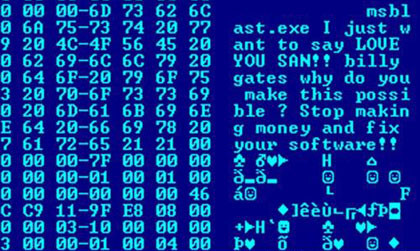Hex dump of the Blaster worm, showing a message left for Microsoft CEO Bill Gates
by the worm's programmer http://nuevovirus.info/virus-blaster/, Public Domain, wikimedia.org
by the worm's programmer http://nuevovirus.info/virus-blaster/, Public Domain, wikimedia.org
A computer virus is a malware program that, when executed, replicates by inserting copies of itself (possibly modified) into other computer programs, data files, or the boot sector of the hard drive. Like the biological viruses from which its name is taken, when this replication succeeds, the affected areas are then said to be "infected."
This area of computer science has borrowed a good number of biological terms.
Viruses often perform some type of harmful activity on infected hosts, such as stealing hard disk space , corrupting data, spamming their contacts, logging their keystrokes, or even rendering the computer useless.
Not all viruses must be destructive or even be hidden. What makes a virus a virus is that it is self-replicating and installs itself without user consent.
Computer scientists have categorized two main kinds of digital viruses. “Zoo viruses” are those that have little chance of spreading. Like zoo animals, they are often collected and preserved.
Viruses that exist “in the wild” are much harder to control—some are shape-shifters that imitate more benign forms of code, while others are parasitic and invade computers, phone systems, and other networks.
Though we think of viruses as part of the more modern Internet age, in 1949 by John von Neumann gave lectures about the "automata" and published the "Theory of self-reproducing automata"which described how a computer program could be designed to reproduce itself, and his design for a self-reproducing computer program is considered the world's first computer virus. He is at least the theoretical father of computer virology.





